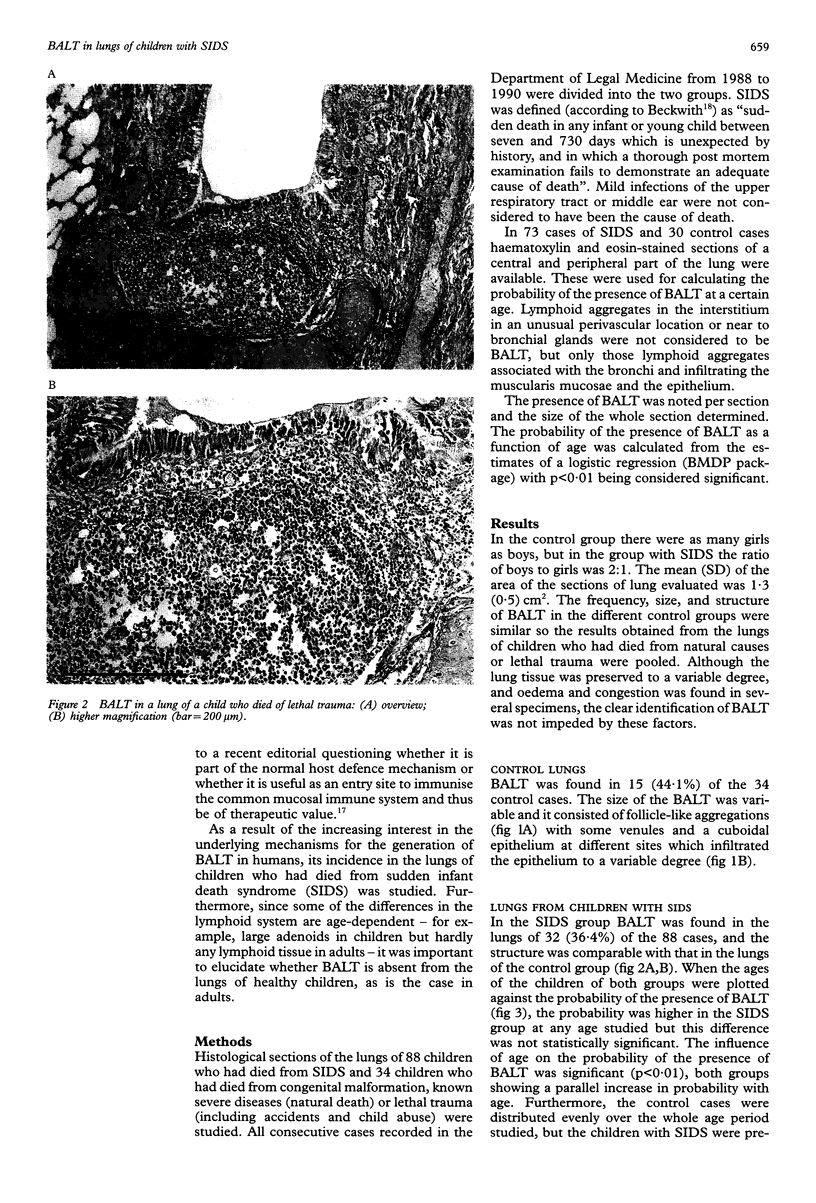Abstract
BACKGROUND--Bronchus-associated lymphoid tissue (BALT) is well characterised in rabbits and rats. In humans, however, it does not seem to be present in the healthy adult lung, although it can develop after certain microbial stimulation. METHODS--In the present study a consecutive series of lungs from 88 children who had died of sudden infant death syndrome (SIDS) and 34 control cases of comparable age were examined for the presence of BALT. RESULTS--BALT was present in 36.4% of the patients who had died of SIDS and in 44.1% of the control cases. The probability of finding BALT increased with age, with similar kinetics in both groups. CONCLUSIONS--Future studies need to define when and at what rate BALT disappears as children get older. In young children BALT may act as an entry site for antigens to initiate an immune response, as is well documented for the gut-associated lymphoid system.
Full text
PDF


Images in this article
Selected References
These references are in PubMed. This may not be the complete list of references from this article.
- Bienenstock J., Johnston N., Perey D. Y. Bronchial lymphoid tissue. I. Morphologic characteristics. Lab Invest. 1973 Jun;28(6):686–692. [PubMed] [Google Scholar]
- Bienenstock J., Johnston N., Perey D. Y. Bronchial lymphoid tissue. II. Functional characterisitics. Lab Invest. 1973 Jun;28(6):693–698. [PubMed] [Google Scholar]
- Delventhal S., Brandis A., Ostertag H., Pabst R. Low incidence of bronchus-associated lymphoid tissue (BALT) in chronically inflamed human lungs. Virchows Arch B Cell Pathol Incl Mol Pathol. 1992;62(4):271–274. doi: 10.1007/BF02899692. [DOI] [PubMed] [Google Scholar]
- Emery J. L., Dinsdale F. Increased incidence of lymphoreticular aggregates in lungs of children found unexpectedly dead. Arch Dis Child. 1974 Feb;49(2):107–111. doi: 10.1136/adc.49.2.107. [DOI] [PMC free article] [PubMed] [Google Scholar]
- Emery J. L., Dinsdale F. The postnatal development of lymphoreticular aggregates and lymph nodes in infants' lungs. J Clin Pathol. 1973 Jul;26(7):539–545. doi: 10.1136/jcp.26.7.539. [DOI] [PMC free article] [PubMed] [Google Scholar]
- Gould S. J., Isaacson P. G. Bronchus-associated lymphoid tissue (BALT) in human fetal and infant lung. J Pathol. 1993 Feb;169(2):229–234. doi: 10.1002/path.1711690209. [DOI] [PubMed] [Google Scholar]
- Gould S. J., Isaacson P. G. Bronchus-associated lymphoid tissue (BALT) in human fetal and infant lung. J Pathol. 1993 Feb;169(2):229–234. doi: 10.1002/path.1711690209. [DOI] [PubMed] [Google Scholar]
- Holt P. G. Development of bronchus associated lymphoid tissue (BALT) in human lung disease: a normal host defence mechanism awaiting therapeutic exploitation? Thorax. 1993 Nov;48(11):1097–1098. doi: 10.1136/thx.48.11.1097. [DOI] [PMC free article] [PubMed] [Google Scholar]
- Holt P. G. Immunoprophylaxis of atopy: light at the end of the tunnel? Immunol Today. 1994 Oct;15(10):484–489. doi: 10.1016/0167-5699(94)90194-5. [DOI] [PubMed] [Google Scholar]
- Holt P. G. Regulation of antigen-presenting cell function(s) in lung and airway tissues. Eur Respir J. 1993 Jan;6(1):120–129. [PubMed] [Google Scholar]
- Li G., Hansmann M. L., Zwingers T., Lennert K. Primary lymphomas of the lung: morphological, immunohistochemical and clinical features. Histopathology. 1990 Jun;16(6):519–531. doi: 10.1111/j.1365-2559.1990.tb01157.x. [DOI] [PubMed] [Google Scholar]
- McGhee J. R., Kiyono H. New perspectives in vaccine development: mucosal immunity to infections. Infect Agents Dis. 1993 Apr;2(2):55–73. [PubMed] [Google Scholar]
- Pabst R., Gehrke I. Is the bronchus-associated lymphoid tissue (BALT) an integral structure of the lung in normal mammals, including humans? Am J Respir Cell Mol Biol. 1990 Aug;3(2):131–135. doi: 10.1165/ajrcmb/3.2.131. [DOI] [PubMed] [Google Scholar]
- Pabst R. Is BALT a major component of the human lung immune system? Immunol Today. 1992 Apr;13(4):119–122. doi: 10.1016/0167-5699(92)90106-H. [DOI] [PubMed] [Google Scholar]
- Richmond I., Pritchard G. E., Ashcroft T., Avery A., Corris P. A., Walters E. H. Bronchus associated lymphoid tissue (BALT) in human lung: its distribution in smokers and non-smokers. Thorax. 1993 Nov;48(11):1130–1134. doi: 10.1136/thx.48.11.1130. [DOI] [PMC free article] [PubMed] [Google Scholar]
- Sato A., Chida K., Iwata M., Hayakawa H. Study of bronchus-associated lymphoid tissue in patients with diffuse panbronchiolitis. Am Rev Respir Dis. 1992 Aug;146(2):473–478. doi: 10.1164/ajrccm/146.2.473. [DOI] [PubMed] [Google Scholar]
- Sminia T., van der Brugge-Gamelkoorn G. J., Jeurissen S. H. Structure and function of bronchus-associated lymphoid tissue (BALT). Crit Rev Immunol. 1989;9(2):119–150. [PubMed] [Google Scholar]




